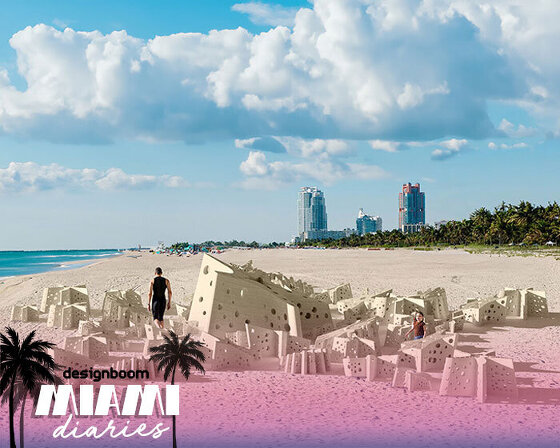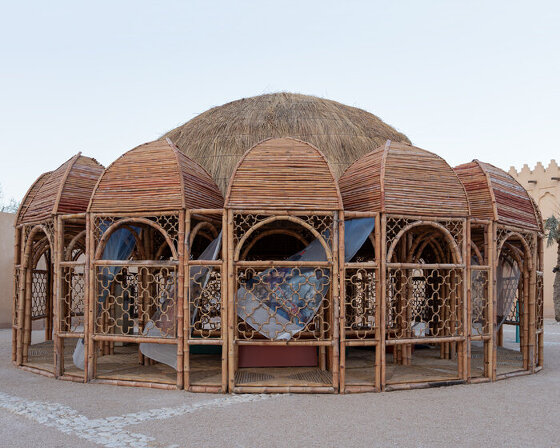designboom traveled all the way to the lagoon of the sirru fen fushi island in the maldives to do a very special ‘studio visit’ where we documented the sculptural — and still under construction — coralarium installation. once finished, this ever-changing underwater art museum by artist jason decaires taylor will make for spectacular snorkeling and diving, offering visitors a unique, cultural eco-art attraction whilst creating the foundations of an artificial reef to enhance the underwater ecosystem.

water villas at fairmont maldives sirru fen fushi
image courtesy fairmont maldives
for those eager to know, coralarium is situated in the center of the largest developed coral lagoon in the maldives, on the island resort of fairmont maldives sirru fen fushi. it’s the sole hotel on the pristine atoll and its previously untouched location that has allowed marine life to flourish, with manta rays, turtles, large pods of bottlenose dolphins and spinner dolphins as regular visitors in the crystal-clear waters of the 600- hectare lagoon.

designboom’s editor-in-chief birgit lohmann snorkels around the first submerged sculptures
all images by designboom, unless otherwise stated
designboom spent four incredible days in the water with the artist to document the immersive installation. home to the island’s first coral regeneration project, the fairmont maldives sirru fen fushi will host the coralarium building which will be assembled underwater. the structure, made of marine grade stainless steel and polished to a high gloss to reflect the sun’s rays and surroundins, understands the importance of the fragile environment.
‘as the location for the maldives’ first underwater art installation we hope to raise awareness that encourages long-term reef protection and sustainable tourism’, says denis dupart, general manager of fairmont maldives sirru fen fushi.

the underwater realm of the installation includes a series of children looking up towards the surface of the sea posing questions about the threat of climate change and sea levels rising and the consequences for future generations. overall the installation aims to draw all the elements of life on earth together, portraying a system where all components are dependent on each other: humans and the environment in coexistence — a leveling of relationships.

the ‘coralarium’ is a special challenge for taylor because, unlike his previous museums, it is actually a building that he is building himself and the development has proven to be more difficult than expected. sirru fen fushi is located in the northern shaviyani atoll, over an hour’s flight from the capital malé, and all the equipment and machinery needed to build the museum has to be transported to the remote island with great complications. if something unforeseen happens – and it does all the time – the supply of materials and tools is correspondingly time-consuming.
the previous week to our visit saw heavy storms, which is why the timetable is now lagging behind and entered the month of fasting – ramadan – which is taken very seriously in the strictly muslim country. as it turns out, the workers observe the religious practice, and from early hours until sunset, they do not consume any food or drink fluids. especially when working as a diver, this is not particularly beneficial.
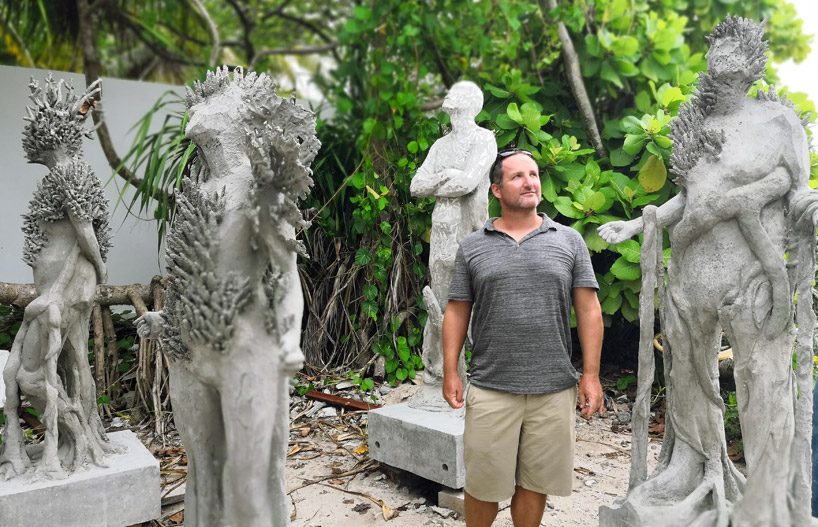
artist, marine conservationist and underwater photographer jason decaires taylor wants to educate those who experience the installation by getting them to think of the relationship between nature and humans, and in the process, give marine life here another space to inhabit
‘when the owners contacted me about a year ago, I proposed an architecture project with an area of twelve by twelve and a height of six meters – a gallery exposed to the tides. we will have sculptures on the roof that correspond to the sky and the atmosphere. and sculptures inside, partly in the water, and there are some that are completely submerged. something like a zoo with human creatures, who are put in a cage for the sea creatures to admire.’ jason decaires taylor

the sculptures — a group of strange hybrid beings — are placed on the edge of the construction site, waiting to be handed over to the floods. poured from pH-neutral concrete, some of them ‘grow’ banyan roots and screw trees from the extremities, while others carry stone and mushroom coral on the body
also, a few months ago, one of the workers shot a photo of the sculptures and then uploaded it to his facebook page. this picture made its rounds and led to the rumor that sirru fen fushi would build a temple in the sea. only a clarifying appointment in parliament could save the ‘coralarium’ in a country that doesn’t allow art museums. it has been difficult to convince the administration of the need for an underwater museum full of sculptures, given that sunni islam, which is predominantly practiced in the maldives, actually prohibits sculpture.

each hybrid sculpture is designed to attract specific types or marine life from fish to sponges, soft coral, hard coral, crustaceans and octopus.
the sculptures themselves are hybrid forms, part-human, part-plant, part-coral. the organic forms are based on endemic species of the island and its surrounding reefs; banyan trees, screw pines, strangler ivy, mushroom and staghorn corals. many of the works feature root systems, symbolic of the dependence of humans on the natural environment. white calcium coral, formed of bones ingrained into the surface of works, aims to show how the reef is part of the maldivian DNA.

the statues are formed above ground and incorporate endemic environmental elements: some sculptures have tree trunks growing where their legs should be, others are embedded with the patterns of corals

because corals are extremely sensitive to the unusually high water temperatures in the maldives, there is a widespread dying of cnidarians … most people only develop an understanding of a problem if they find themselves in it and so taylor works to create awareness.

ph neutral, non-toxic concrete and artificial coral fragments

light effects are changing by the hour
rendering by jason decaires taylor
the centre piece will be the coral cube, the worlds first semi submerged art space, a portal to the underwater realm offering visitors ephemeral encounters with the natural beauty beneath the water’s surface. delivering an other worldly experience that illustrates the connectivity of man with nature, a hybrid organic form in harmony with its surroundings, a seamless link between the land and the ocean, combines two disparate wonders, one created by man and one designed by nature.
after a 50m snorkel/swim you encounter a submerged staircase which leads up towards a semi submerged tidal building. the building is cube shaped, six metres tall, with its front façade submerged up to median tide of three metres. the design of the walls is based on natural coral structures and is porous to allow the tides, current and marine life to pass through it and the structure to ‘breathe’ within its location. the complex structural formation is designed to dissipate oceanic forces whilst creating a protective space that encourages nature to colonise and seek refuge. the construction, using high grade, polished, marine stainless steel aims to reflect and mirror the surrounding blues of the coral atoll and the sky above. a mirage on the horizon, that over time will take on the patina of the sea as it becomes colonised by algae and weathers within the environment. the roof of the building houses a series of black silhouetted jesmonite sculptures that connect both the sky above and the sea below, occupying a space between worlds.

you have to picture it as a gallery exposed to the tides
rendering by jason decaires taylor
the artwork created by renowned environmental sculptor jason decaires taylor is a semi-submerged tidal gallery space that exhibits a series of sculptural artworks on the skyline, inter-tidal waterline and seabed. the entrance of the building is situated above water and leads into a dry elevated viewing platform. the square gallery space exhibits a further 14 sculptures on plinths at various heights within the water column, some works completely submerged, others high above the water line, with the majority mid water interacting with both the marine and terrestrial world depending on the tidal level. the roof is perforated with a coral pattern to allow beams of light to illuminate the individual works and a series of submerged lights to illuminate the space during the night.
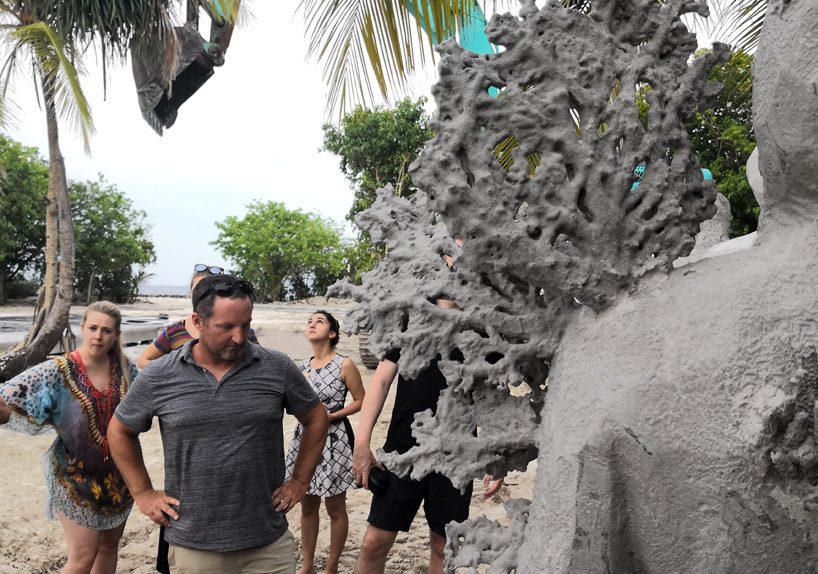
the sculptures are all made from marine-grade cement that is completely free of other substances, such as metals, that could be harmful to marine life; the material has proven to be the most useful substance in the support of reef growth.
 taylor also leaves patches of rough texture on his sculptures to help coral larvae gain a strong foothold
taylor also leaves patches of rough texture on his sculptures to help coral larvae gain a strong foothold
our reefs are dying and the ocean is in trouble. on the other hand, the ‘coralarium’ could also attract even more visitors to the maldives and thus aggravate the situation. ‘you could see it that way, but most people only develop an understanding of a problem if they find themselves in it.’ says taylor, ‘we don’t really see the sea. we see an enormous and fragile element and the horizon. the danger is that if we don’t experience underwater life, we take it for granted. this is just the beginning of a mission. for the first time I will be submerging a major architectural structure to house a series of hybrid organic inspired sculptures in a protected coral lagoon. in defence of the sea, I’m trying to provide rest for the natural overstressed areas, so that visitors can divide half their time between the museum, an extremely vibrant ecosystem marvel, and the natural reef.’
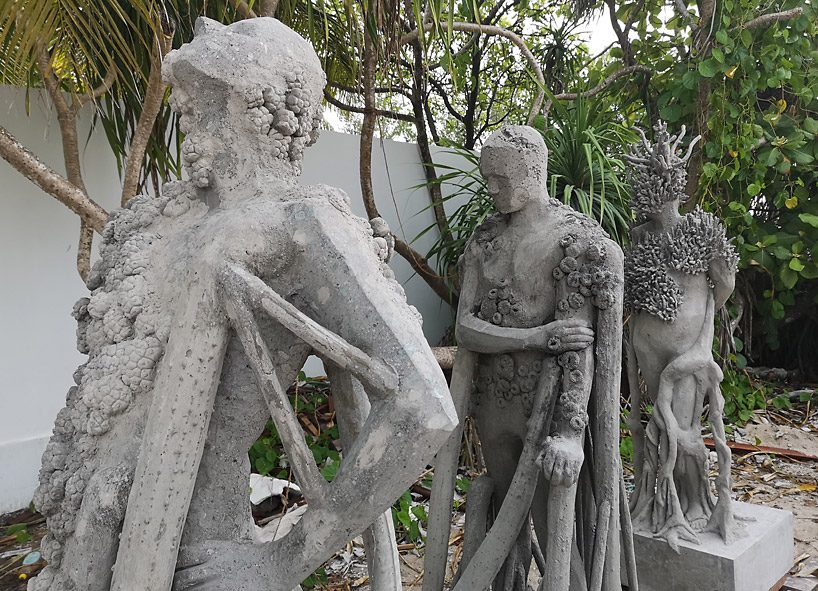
creating artificial reefs benefits marine life in two ways: by creating a reef system for life to thrive in, and by taking pressure off of natural reefs, which have been over-fished and over-visited.

the sculptures are a commentary on rising sea levels and our inherent connection and dependence on the marine environment
though shallow seas constitute only eight percent of the world’s oceans, they’re thought to contain the majority of marine life—life that is under constant threat from the disappearance of coral reefs, thriving ecosystems that house thousands of marine species.

as soon as the excavator has laboriously pulled the dock to where the tons of foundations are to be sunk, a storm comes out of the blue, and the matter must be adjourned again.
the ‘coralarium’, located within easy swimming distance from the beach bar, becomes a portal or interface to the wonders of the underwater world. access will be through guided tours in small groups lead by the resort’s resident marine biologists and will be available several times a day.

the excavator stands at the front of the floating dock

image courtesy fairmont maldives
the decay of coral reef environments is caused in part by ocean acidification. as the ocean absorbs the human-made carbon emissions, almost 40 percent of coral reefs have disappeared within the past few decades—and scientists warn that nearly 80 percent could be gone by 2050.
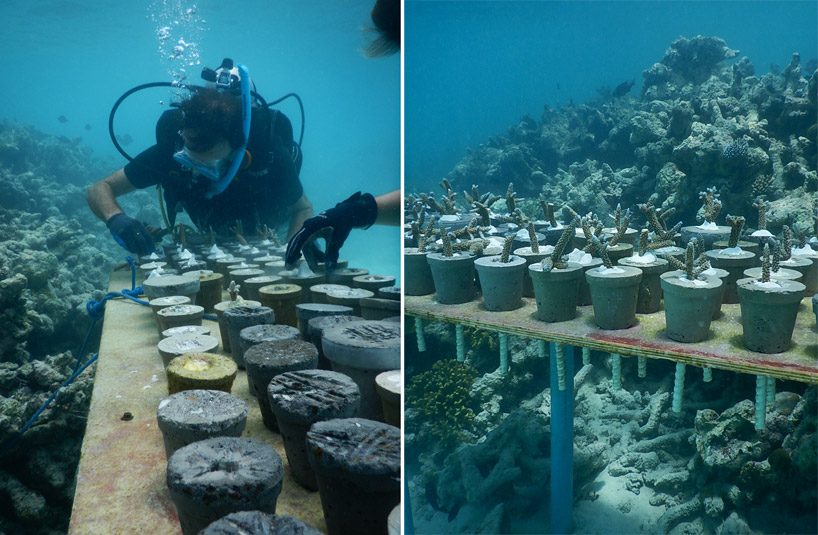 gardening is not just for green houses : coral aquaculture!
gardening is not just for green houses : coral aquaculture!
images courtesy fairmont maldives
‘coral aquaculture’ or ‘coral reef farming’ is the extracting of segments or larva of live corals from a reef and growing them in a nursery until adulthood. the technique involves treating coral as if it were a plant.

small corals are propagated in nurseries, when grown can be transplanted into the reef
image courtesy fairmont maldives

about jason decaires taylor
in 2006, the 43-year-old sculptor designed the ‘molinere underwater sculpture park’ off the coast of grenada, processing around 15 tonnes of cement into over 65 sculptures and placing them on the sea floor. for the ‘museo subacuático de arte’, MUSA for short, in cancún (in 2009) he created nearly 500 sculptures. in new providence in the bahamas, jason decaires taylor has set ‘ocean atlas’ within the aquamarine depths of nassau’s seas (2014). the last major project to date, the ‘museo atlántico’ (2016) in lanzarote, is made of more than 300 sculptures at a depth of 14 meters, viewable for visitors that have a corresponding diving license.
architecture in the maldives (14)
climate change (160)
coral (33)
jason decaires taylor (11)
ocean awareness and activism (153)
PRODUCT LIBRARY
a diverse digital database that acts as a valuable guide in gaining insight and information about a product directly from the manufacturer, and serves as a rich reference point in developing a project or scheme.

























